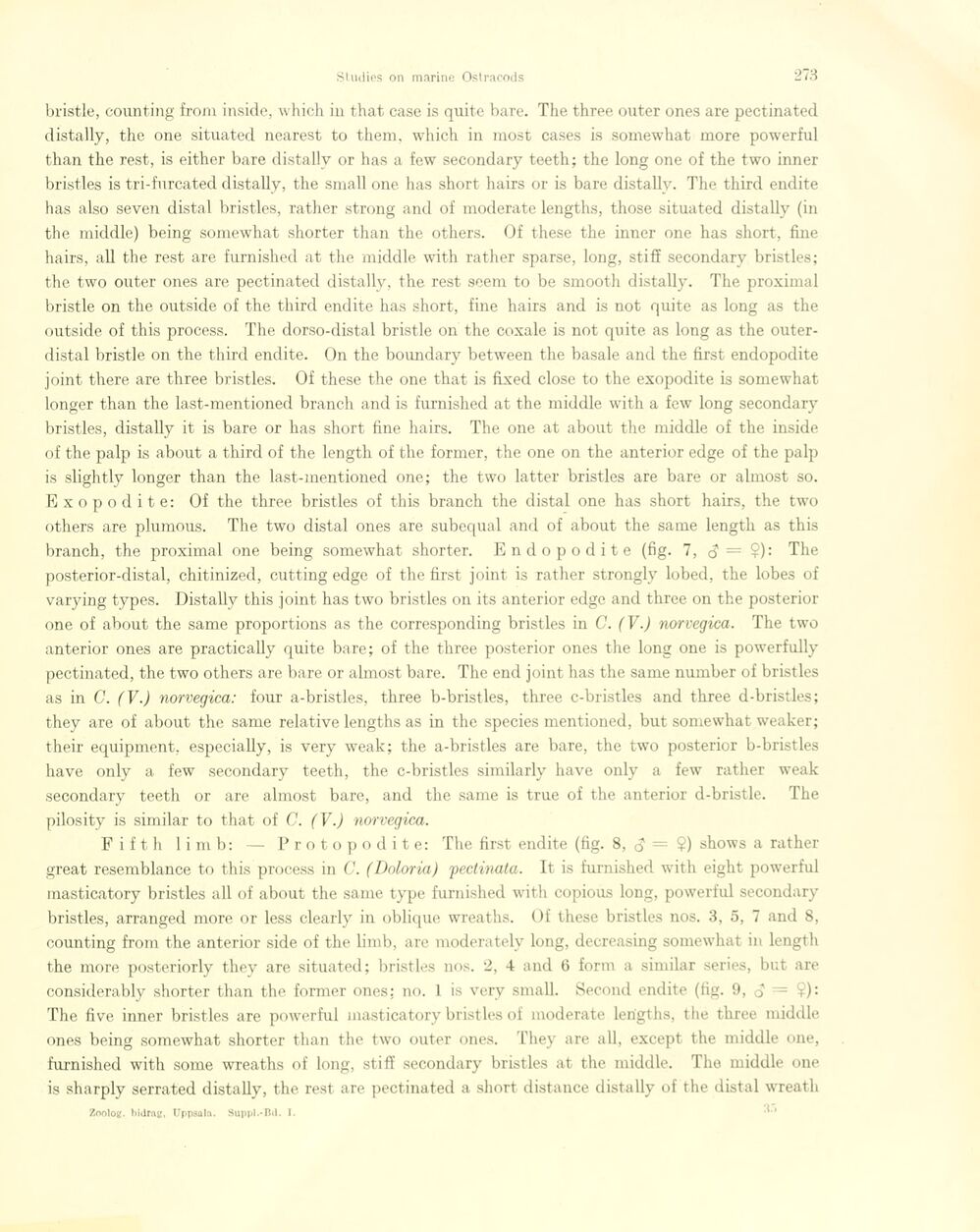
Full resolution (JPEG) - On this page / på denna sida - Sidor ...

<< prev. page << föreg. sida << >> nästa sida >> next page >>
Below is the raw OCR text
from the above scanned image.
Do you see an error? Proofread the page now!
Här nedan syns maskintolkade texten från faksimilbilden ovan.
Ser du något fel? Korrekturläs sidan nu!
This page has never been proofread. / Denna sida har aldrig korrekturlästs.
bristle, counting from inside, which in that case is quite bare. The three outer ones are pectinated
distally, the one situated nearest to them, which in most cases is somewhat more powerful
than the rest, is either bare distally or has a few secondary teeth; the long one of the two inner
bristles is tri-furcated distally, the small one has short hairs or is bare distallv. The third endite
has also seven distal bristles, rather strong and of moderate lengths, those situated distally (in
the middle) being somewhat shorter than the others. Of these the inner one has short, fine
hairs, all the rest are furnished at the middle with rather sparse, long, stiff secondary bristles;
the two outer ones are pectinated distally, the rest seem to be smooth distally. The proximal
bristle on the outside of the third endite has short, fine hairs and is not quite as long as the
outside of this process. The dorso-distal bristle on the coxale is not quite as long as the
outer-distal bristle on the third endite. On the boundary between the basale and the first endopodite
joint there are three bristles. Of these the one that is fixed close to the exopodite is somewhat
longer than the last-mentioned branch and is furnished at the middle with a few long secondary
bristles, distally it is bare or has short fine hairs. The one at about the middle of the inside
of the palp is about a third of the length of the former, the one on the anterior edge of the palp
is slightly longer than the last-mentioned one; the two latter bristles are bare or almost so.
Exopodite: Of the three bristles of this branch the distal one has short hairs, the two
others are plumous. The two distal ones are subequal and of about the same length as this
branch, the proximal one being somewhat shorter. Endopodite (fig. 1, S = ?)•’ The
posterior-distal, chitinized, cutting edge of the first joint is rather strongly lobed, the lobes of
varying types. Distally this joint has two bristles on its anterior edge and three on the posterior
one of about the same proportions as the corresponding bristles in C. ( V.) norvegica. The two
anterior ones are practically quite bare; of the three posterior ones the long one is powerfully
pectinated, the two others are bare or almost bare. The end joint has the same number of bristles
as in C. (V.) norvegica: four a-bristles, three b-bristles, three c-bristles and three d-bristles;
they are of about the same relative lengths as in the species mentioned, but somewhat weaker;
their equipment, especially, is very weak; the a-bristles are bare, the two posterior b-bristles
have only a few secondary teeth, the c-bristles similarly have only a few rather weak
secondary teeth or are almost bare, and the same is true of the anterior d-bristle. The
pilosity is similar to that of C. (V.) norvegica.
F i f t h 1 i m b: — P r o t o p o d i t e: The first endite (fig. 8, o = ?) shows a rather
great resemblance to this process in C. (Doloria) pectinata. It is furnished with eight powerful
masticatory bristles all of about the same type furnished with copions long, powerful secondary
bristles, arranged more or less clearly in oblique wreaths. Of these bristles nos. 3, 5, 7 and 8,
counting from the anterior side of the limb, are moderately long, decreasing somewhat in lengtli
the more posteriorly they are situated; bristles nos. 2, 4 and 6 form a similar series, but are
considerably shorter than the former ones; no. 1 is very small. Second endite (fig. 9, o = t):
The five inner bristles are pow’erful masticatory bristles of moderate lengths, the three middle
ones being somewhat shorter than the two outer ones. They are all, except the middle one,
furnished with some wreaths of long, stiff secondary bristles at the middle. The middle one
is sharply serrated distally, the. rest are pectinated a short distance distally of the distal wreath
Zoolog, bidrag, Upp3üla. Suppl .-Bel. I.
<< prev. page << föreg. sida << >> nästa sida >> next page >>